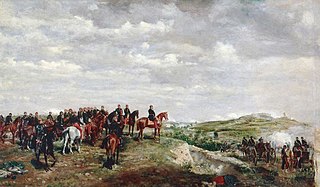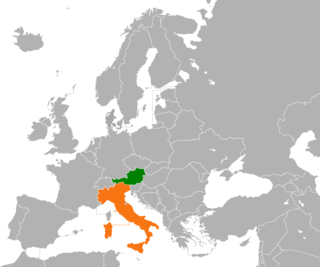Related Research Articles

The War of the Polish Succession was a major European conflict sparked by a Polish civil war over the succession to Augustus II of Poland, which the other European powers widened in pursuit of their own national interests. France and Spain, the two Bourbon powers, attempted to test the power of the Austrian Habsburgs in Western Europe, as did the Kingdom of Prussia, whilst Saxony and Russia mobilized to support the eventual Polish victor. The fighting in Poland resulted in the accession of Augustus III, who in addition to Russia and Saxony, was politically supported by the Habsburgs.

The War of the Austrian Succession was a European conflict that took place between 1740 and 1748. Fought primarily in Central Europe, the Austrian Netherlands, Italy, the Atlantic and Mediterranean, related conflicts included King George's War in North America, the War of Jenkins' Ear, the First Carnatic War and the First and Second Silesian Wars.

Charles Emmanuel III was Duke of Savoy and King of Sardinia from 1730 until his death.

The Second Italian War of Independence, also called the Franco-Austrian War, the Austro-Sardinian War or Italian War of 1859, was fought by the Second French Empire and the Savoyard Kingdom of Sardinia against the Austrian Empire in 1859 and played a crucial part in the process of Italian Unification.

The Battle of Bassignana was fought in the Italian campaign of the War of the Austrian Succession on 27 September 1745. It resulted in a victory for the combined armies of the Bourbon kingdoms of France and Spain and the Genoese Republic over Austria and the Kingdom of Sardinia.
The Treaty of Zurich was signed by the Austrian Empire, the French Empire, and the Kingdom of Sardinia on 10 November 1859. The agreement was a reaffirmation of the terms of the preliminary peace of Villafranca, which brought the Austro-Sardinian War to an official close. The treaty actually consisted of three separate treaties – a treaty between France and Austria, which reaffirmed the terms of the preliminary peace, re-established peace between the two emperors, and ceded Lombardy to France. A second treaty, between France and Sardinia, saw France cede Lombardy to Sardinia. The third treaty, signed by all three powers, re-established a state of peace between Austria and Sardinia.

The Battle of Assietta was a significant engagement of the War of the Austrian Succession and pitted a numerically superior French force of 25,000 men under the command of Louis Fouquet, Chevalier de Belle-Isle against a Sardinian army of 15,000 men led by Giovanni Bricherasio. The French were soundly defeated and their commander, Belle-Isle, killed during the course of the battle. The siege was part of the Italian campaign of the War of the Austrian Succession, in which Habsburgs and Bourbons contested for domination over Northern Italy and the various Italian states. The Kingdom of Sardinia joined the war on the side of the Pragmatic Allies in 1742 and rallied itself to Maria Theresa's cause. There also were concerns about growing French influence in its territories. The war in Italy had already been going on for seven years, and the Sardinian army had already suffered several defeats in the field, leading to them opting for a more defensive approach. The French led several expeditions in Italy during the war, combining their forces with the Spanish Bourbons to accomplish their political aims.

Foreign relations exist between Austria and Italy. Austria has an embassy in Rome, a general consulate in Milan and 10 honorary consulates. Italy has an embassy in Vienna, a consulate in Innsbruck, and 5 honorary consulates . Italy has given full support to Austria's membership of the European Union.
The Anglo-French Alliance is the name for the alliance between Great Britain and France between 1716 and 1731. It formed part of the stately quadrille in which the Great Powers of Europe repeatedly switched partners to try to build a superior alliance.

The Kingdom of Sardinia, also referred to as the Kingdom ofSardinia-Piedmont or Piedmont-Sardinia during the Savoyard period, was a state in Southern Europe from the early 14th until the mid-19th century.

Michelangelo Alessandro Colli-Marchi, or Michele Angelo Alessandro Colli-Marchei or Michael Colli, joined the Austrian army, became a general officer, and led the army of the Kingdom of Sardinia-Piedmont for three years, including its unsuccessful campaign against Napoleon Bonaparte in 1796. In early 1797, he was given command of the army of the Papal States, but was defeated at Faenza.

Vicente Bacallar y Sanna, 1st Marquess of San Felipe, later italianized into Vincenzo Bacallar Sanna, 6 February 1669 – The Hague (Netherlands), 11 June 1726). He was a Sardinian nobleman, military officer, linguist, historian, politician and ambassador of the Spanish Empire. He was born to a noble Sardinian family when the kingdom of Sardinia was part of the Spanish crown.

The Second Battle of Saorgio was fought from 24 to 28 April 1794 between a French First Republic army commanded by Pierre Jadart Dumerbion and the armies of the Kingdom of Sardinia-Piedmont and the Habsburg monarchy led by Joseph Nikolaus De Vins. It was part of a successful French offensive designed to capture strategic positions in the Maritime Alps and Ligurian Alps, and on the Mediterranean coast. Tactical control of the battle was exercised by André Masséna for the French and Michelangelo Alessandro Colli-Marchi for the Coalition. Saorge is located in France, about 70 kilometres (43 mi) northeast of Nice. At the time of the battle, the town was named Saorgio and belonged to Piedmont.

The Piedmontese Republic was a revolutionary, provisional and internationally unrecognized government established in Turin between 1798 and 1799 on the territory of Piedmont during its military rule by the French First Republic.

The Plombières Agreement of the 21 July 1858 was a secret verbal agreement which took place at Plombières-les-Bains between the chief minister of Piedmont-Sardinia, Count Cavour, and the French Emperor, Napoleon III. Some older English languages refer to it as the Treaty of Plombières. In modern times, it is merely referred to as an "agreement", since nothing was actually signed.

The French expedition to Sardinia was a short military campaign fought in 1793 in the Mediterranean Sea in the first year of the War of the First Coalition, during the French Revolutionary Wars. The operation was the first offensive by the new French Republic in the Mediterranean during the conflict, and was directed at the island of Sardinia, part of the Kingdom of Sardinia. Sardinia was neutral at the time, but immediately joined the anti-French coalition. The operation was a failure, with attacks directed at Cagliari in the south and La Maddalena in the north both ending in defeat.

The Royal Sardinian Navy was the naval force of the Kingdom of Sardinia. The fleet was created in 1720 when the Duke of Savoy, Victor Amadeus II, became the King of Sardinia. Victor Amadeus had acquired the vessels be used to establish the fleet while he was still the King of Sicily in 1713. The Sardinian Navy saw action in a number of conflicts, including the French Revolutionary Wars and the Napoleonic Wars from the 1790s to 1810s, limited actions against the Barbary Coast such as the Battle of Tripoli in 1825, and the Second Italian War of Independence in 1859. The last war was a major step toward Italian unification, which led to the creation of a united Italian state in 1861. During the fighting in 1860, the Royal Neapolitan Navy defected to Sardinia and placed itself under Sardinian control; in 1861, the navy also absorbed the Royal Sicilian Navy, resulting in the creation of the Regia Marina, which itself became the Marina Militare, the modern Italian navy, in 1946.

The Regiment "Nizza Cavalleria" (1st) is a cavalry unit of the Italian Army based in Bellinzago Novarese in Piedmont. The regiment is the reconnaissance unit of the Alpine Brigade "Taurinense".

The Treaty of Nymphenburg was a treaty between Bavaria and Spain that was concluded on May 28, 1741 at the Nymphenburg Palace in Munich. It was the first formal pact of a series of French-sponsored alliances against the Habsburg Monarch, Maria Theresa. Through the agreement, the Bavarian Elector Charles Albert gained the support of King Philip V of Spain to become the next Holy Roman Emperor against the claims of the Habsburgs. The treaty was brokered by Marshal Belleisle under the authority of Louis XV of France. As part of the negotiations, the French agreed to materially support Charles Albert's claims. The treaty signaled the expansion of the First Silesian War, which started as a local war between Prussia and the Habsburg Monarchy, into the War of the Austrian Succession, a pan-European conflict.

The Kingdom of Sardinia, also referred to as the Kingdom ofSardinia-Piedmont or Piedmont-Sardinia during the Savoyard period, was a state in Southern Europe from the early 14th until the mid-19th century.